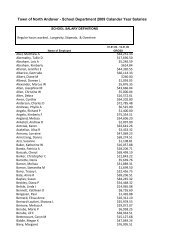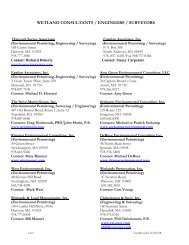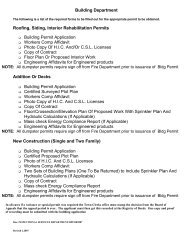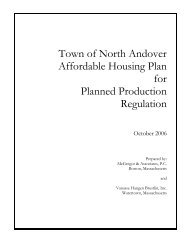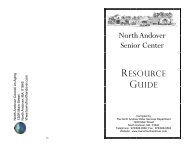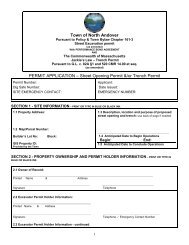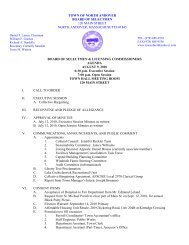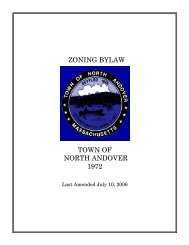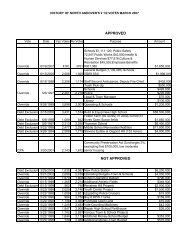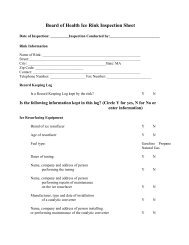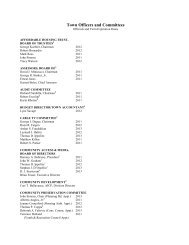Open Space and Recreation Plan - Town of North Andover
Open Space and Recreation Plan - Town of North Andover
Open Space and Recreation Plan - Town of North Andover
Create successful ePaper yourself
Turn your PDF publications into a flip-book with our unique Google optimized e-Paper software.
T O W N O F N O R T H A N D O V E R<br />
O P E N S P A C E A N D R E C R E A T I O N P L A N 2 0 0 6<br />
2 0 1 0 U P D A T E<br />
have driven the town’s origin <strong>and</strong> development, hydropower in particular. Early in the town's history there was<br />
"hardly a stream or brook <strong>of</strong> any size that was not put in requisition by the settlers as waterpower for grinding<br />
or sawing" (Bailey, 1880).<br />
Today, Lake Cochichewick is the sole source <strong>of</strong> public drinking water. An underst<strong>and</strong>ing <strong>of</strong> the vulnerability <strong>of</strong><br />
water resources has been learned the hard way - through the degradation <strong>of</strong> our public water supply. Pollutants<br />
from a number <strong>of</strong> sources including: house construction, septic systems <strong>and</strong> urban stormwater degraded water<br />
quality until 1986 when giardia was discovered in the Lake. A 'boil water order' followed. A filtration plant<br />
was constructed, a three-year building moratorium was instituted throughout the watershed, <strong>and</strong> a<br />
comprehensive watershed study was commissioned. A portion <strong>of</strong> this study's Diagnostic Conclusions provides<br />
a picture <strong>of</strong> the threats to the water supply from increased growth <strong>and</strong> development:<br />
<br />
<br />
<br />
Water quality <strong>of</strong> the inlet streams is degraded compared to water quality in-lake. Given the present<br />
degraded quality <strong>of</strong> inflows, there is potential for in-lake water quality to deteriorate in the future<br />
even without a corresponding degradation <strong>of</strong> inflows.<br />
The watershed to the lake has residential <strong>and</strong> agricultural uses, which contribute to these periodic<br />
water quality problems. Erosion <strong>of</strong> soils in areas <strong>of</strong> new construction <strong>and</strong> agricultural areas, <strong>and</strong> urban<br />
storm water run<strong>of</strong>f appear to be the primary sources <strong>of</strong> elevated suspended solids, nutrients <strong>and</strong><br />
bacteria concentrations.<br />
Over half <strong>of</strong> the watershed to the lake is presently forested, <strong>and</strong> is a prime site for future residential<br />
development. Further development in the watershed will lead to increases in nutrient loading <strong>and</strong><br />
urban stormwater run<strong>of</strong>f. Lake development is experiencing low growth <strong>and</strong> is expected to continue<br />
in that fashion.<br />
(IEP, 1987)<br />
As a result <strong>of</strong> the Lake Cochichewick Watershed <strong>Plan</strong> (in conjunction with the Balanced Growth <strong>Plan</strong>), a<br />
number <strong>of</strong> steps were taken to protect the water supply. These included major revisions to the Zoning Bylaw,<br />
Board <strong>of</strong> Health Rules <strong>and</strong> Regulations, Wetl<strong>and</strong>s Regulations, l<strong>and</strong> acquisition, increased street sweeping, <strong>and</strong><br />
an extension <strong>of</strong> sewer system. The level <strong>of</strong> success in protecting the water supply, particularly in promulgating<br />
comprehensive recommendations has been greater than in many communities.<br />
Watershed protection measures should manage all threats to the water supply. Updates to the Zoning Bylaw aid<br />
this. In February 1999 the Zoning Bylaw implemented four (4) “No Disturbance” requirements to assist in<br />
preserving the purity <strong>of</strong> groundwater, Lake Cochichewick, <strong>and</strong> its tributaries; to maintain the groundwater<br />
table; <strong>and</strong> to maintain the filtration <strong>and</strong> purification functions <strong>of</strong> the l<strong>and</strong> while preserving the natural<br />
environment <strong>and</strong> protecting the public safely health <strong>and</strong> welfare. The Watershed District is divided into the<br />
following zones:<br />
General Zone:<br />
All l<strong>and</strong> located beyond 400-feet horizontally from the annual mean high<br />
water mark <strong>of</strong> Lake Cochichewick <strong>and</strong> all wetl<strong>and</strong> resources, (as defined in<br />
M.G.L. c131, s.40, <strong>and</strong> the <strong>North</strong> <strong>Andover</strong> Wetl<strong>and</strong>s Bylaw) located within<br />
the watershed.<br />
26




